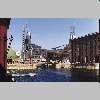|
Amazing
Grace
- Liverpool Looks Up
Liverpool is one
of a number of British Cities looking at competing for the title of
European City of Culture in 2008 as well as celebrating the 800th anniversary
of the City. Already famous for it's football teams, sinking ocean liners,
a band called the Beatles, and an iconic waterfront Liverpool has one
more trick up it's sleeve - the Fourth Grace.
 This
empty space left next to the three signature building's of the city,
including Britain's first skyscraper the Royal Liver Building, has been
opened up to a design competition inviting some of Britain's leading
architects to enter. The brief is to provide a building with cultural
facilities such as a concert hall, to remodel the waterfront into an
attractive plaza, to get people living in the center again by providing
residential housing and to create a signature building that will put
Liverpool on the map as the Guggenheim has done in Bilbao. This
empty space left next to the three signature building's of the city,
including Britain's first skyscraper the Royal Liver Building, has been
opened up to a design competition inviting some of Britain's leading
architects to enter. The brief is to provide a building with cultural
facilities such as a concert hall, to remodel the waterfront into an
attractive plaza, to get people living in the center again by providing
residential housing and to create a signature building that will put
Liverpool on the map as the Guggenheim has done in Bilbao.
The
Contenders...
 #1
Richard Rogers Partnership - Famous
for his avante garde post modernism with such buildings as the Pomipdiou
Centre this entry is something of a depature from his usual designs
looking more like an organic Foster's creation from the late 90s with
surprisingly little piping on the outside. #1
Richard Rogers Partnership - Famous
for his avante garde post modernism with such buildings as the Pomipdiou
Centre this entry is something of a depature from his usual designs
looking more like an organic Foster's creation from the late 90s with
surprisingly little piping on the outside.
The proposal consists of two residential towers of 20 and 30 floors
flanking a wind absorbing mixed use center including public aspects,
office space and a hotel. The public aspects will consist of a 2500
seat auditorium, a martime museum, a jazz and comedy club and even an
observation platform so people can enjoy the views. Parking is also
provided for 700 spaces, and the street planning provides many new retail
opportunities.
 #2
Foster and Partners - Evoking memories of the strong Martime past
Liverpool has Foster has come up with a quite extraordinary design.
With the hull of a ship ending over the water in a box, and topped by
a massive bridge this proposal is certainly imaginative looking. Featuring
four buildings in one that contain all the same aspects as the Rogers
design including a martime museum literally hanging over the water,
this also features a massive covered public space as well as a remodelled
plaza. #2
Foster and Partners - Evoking memories of the strong Martime past
Liverpool has Foster has come up with a quite extraordinary design.
With the hull of a ship ending over the water in a box, and topped by
a massive bridge this proposal is certainly imaginative looking. Featuring
four buildings in one that contain all the same aspects as the Rogers
design including a martime museum literally hanging over the water,
this also features a massive covered public space as well as a remodelled
plaza.
 #3
Edward
Cullinan - With two towers rising up to 35 floors and 500ft in height
this proposal is designed to look more traditional whilst at the same
time being an ultra modern building. A globe shaped 1000 seat theatre,
plus a new marina for barges and a five star hotel are amongst the highlights
for this entrant. There will also be 1500 new parking spaces underground,
perhaps not the most forward looking solution for a 21st century project
to handle the anticipated flood of visitors plus the new residents occupying
the 150 planned apartments in the towers. #3
Edward
Cullinan - With two towers rising up to 35 floors and 500ft in height
this proposal is designed to look more traditional whilst at the same
time being an ultra modern building. A globe shaped 1000 seat theatre,
plus a new marina for barges and a five star hotel are amongst the highlights
for this entrant. There will also be 1500 new parking spaces underground,
perhaps not the most forward looking solution for a 21st century project
to handle the anticipated flood of visitors plus the new residents occupying
the 150 planned apartments in the towers.
 #4
Will Alsop - The sculptor turned architect comes up with
another individual design. Less formed than the previous three entrants
this one is seen as a concept rather than a complete planning document
and is subject to change. Containing 340 residential units, offices,
hotel, retail and lesuire in a series of six conceptual zones up to
20floors in height this is the only design that is not attempting to
dominate the waterfront. The highlights are integrated transport and
a scuplture park to present a history of Liverpool. #4
Will Alsop - The sculptor turned architect comes up with
another individual design. Less formed than the previous three entrants
this one is seen as a concept rather than a complete planning document
and is subject to change. Containing 340 residential units, offices,
hotel, retail and lesuire in a series of six conceptual zones up to
20floors in height this is the only design that is not attempting to
dominate the waterfront. The highlights are integrated transport and
a scuplture park to present a history of Liverpool.

Rogers |

Foster |

Cullinan |

Alsop |
Public consultation
for this scheme has been widespread and the favourite is Cullinan whilst
Alsop is lingering in last place. Rather tellingly Alsop has also come
last in the survey of architects conducted. The developers have been
eager to stress that the public's opinion is more important than anything
else and that they are taking into account all views.
And
the Winner is...
Will Alsop!
Despite being the least formed and arguably most ugly of all the proposals
Alsop has been chosen to design the Fourth Grace for the Liverpool waterfront.
Clearly his attempts not to dominate the entire skyline has paid off,
as his consideration in combining all the elements successfully in what
is a dictionary example of modernism.
It does make a mockery of the public consultation exercise given the
emphasis put on it by the developers and council that they chose the
building that came last and you really do have to wonder how a concept
can be judged on equal merit with three complete designs.
Despite all this though, the Alsop proposal is just the type of building
that ambitious cities like Liverpool build although fears of it being
a white elephant have ensured that Alsop has made concessions to his
critics and promises a further redesign. It will certainly be interesing
to see what he comes up with and let's hope Liverpool it is a big success.
|